Weighted vs Unweighted average for azimuthal integration
The aim of this tutorial is to investigate the ability to preform unweighted averages during azimuthal integration and validate the result for intensity and uncertainties propagation.
[1]:
%matplotlib inline
# use `widget` instead of `inline` for better user-exeperience. `inline` allows to store plots into notebooks.
import time
import numpy
from matplotlib.pyplot import subplots
from scipy.stats import chi2 as chi2_dist
import fabio
import pyFAI
from pyFAI.gui import jupyter
from pyFAI.test.utilstest import UtilsTest
from pyFAI.utils.mathutil import rwp
t0 = time.perf_counter()
[2]:
img = fabio.open(UtilsTest.getimage("Pilatus1M.edf")).data
ai = pyFAI.load(UtilsTest.getimage("Pilatus1M.poni"))
print(ai)
jupyter.display(img)
Detector Pilatus 1M PixelSize= 1.720e-04, 1.720e-04 m BottomRight (3)
Wavelength= 1.000000e-10 m
SampleDetDist= 1.583231e+00 m PONI= 3.341702e-02, 4.122778e-02 m rot1=0.006487 rot2=0.007558 rot3=0.000000 rad
DirectBeamDist= 1583.310 mm Center: x=179.981, y=263.859 pix Tilt= 0.571° tiltPlanRotation= 130.640° 𝛌= 1.000Å
[2]:
<Axes: >
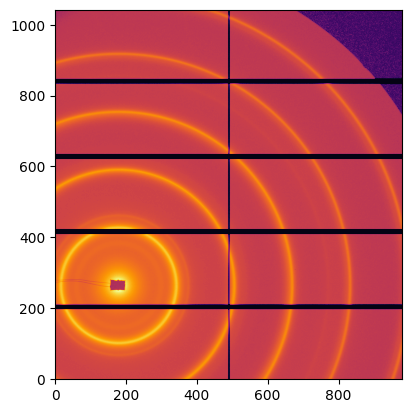
[3]:
method = pyFAI.method_registry.IntegrationMethod.parse(("no", "csr", "cython"), dim=1)
weighted = method
unweighted = method.unweighted
[4]:
#Note
weighted.weighted_average, unweighted.weighted_average, weighted == unweighted
[4]:
(True, False, True)
[5]:
res_w = ai.integrate1d(img, 1000, method=weighted, error_model="poisson", polarization_factor=0.99)
res_u = ai.integrate1d(img, 1000, method=unweighted, error_model="poisson", polarization_factor=0.99)
rwp(res_u, res_w)
[5]:
0.0026844928696383593
[6]:
ax = jupyter.plot1d(res_w, label="weighted")
ax = jupyter.plot1d(res_u, label="unweighted", ax=ax)
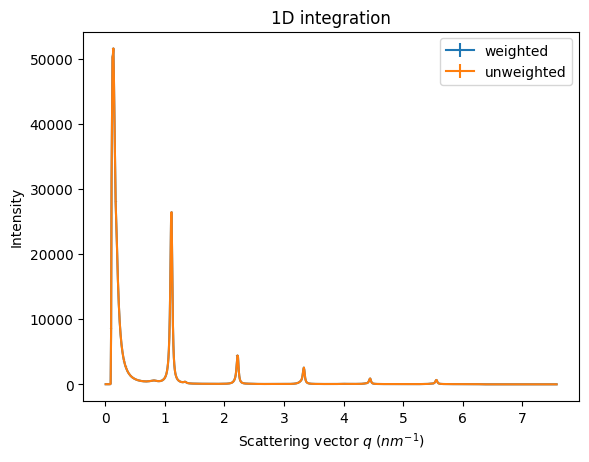
About statstics
Work on a dataset with 1000 frames in a WAXS like configuration
[7]:
ai_init = {"dist":0.1,
"poni1":0.1,
"poni2":0.1,
"rot1":0.0,
"rot2":0.0,
"rot3":0.0,
"detector": "Pilatus1M",
"wavelength":1e-10}
ai = pyFAI.load(ai_init)
unit = pyFAI.units.to_unit("q_A^-1")
detector = ai.detector
npt = 1000
nimg = 1000
wl = 1e-10
I0 = 1e4
polarization = 0.99
kwargs = {"npt":npt,
"polarization_factor": polarization,
"safe":False,
"error_model": pyFAI.containers.ErrorModel.POISSON}
print(ai)
Detector Pilatus 1M PixelSize= 1.720e-04, 1.720e-04 m BottomRight (3)
Wavelength= 1.000000e-10 m
SampleDetDist= 1.000000e-01 m PONI= 1.000000e-01, 1.000000e-01 m rot1=0.000000 rot2=0.000000 rot3=0.000000 rad
DirectBeamDist= 100.000 mm Center: x=581.395, y=581.395 pix Tilt= 0.000° tiltPlanRotation= 0.000° 𝛌= 1.000Å
[8]:
# Generation of a "SAXS-like" curve with the shape of a lorentzian curve
flat = numpy.random.random(detector.shape) + 0.5
[9]:
qmax = ai.integrate1d(flat, method=method, **kwargs).radial.max()
q = numpy.linspace(0, ai.array_from_unit(unit="q_A^-1").max(), npt)
I = I0/(1+q**2)
jupyter.plot1d((q,I))
pass
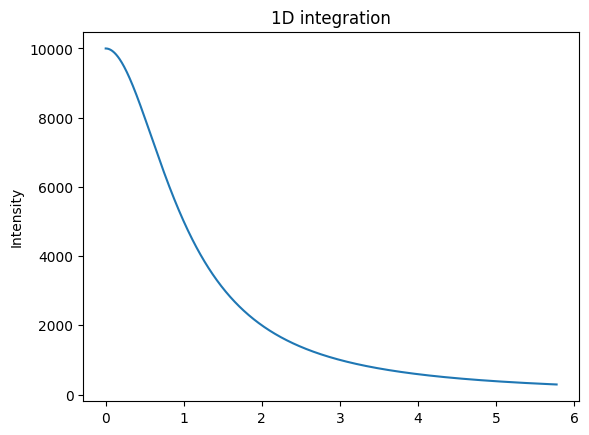
[10]:
#Reconstruction of diffusion image:
img_theo = ai.calcfrom1d(q, I, dim1_unit=unit,
correctSolidAngle=True,
flat=flat,
polarization_factor=polarization,
mask=ai.detector.mask)
kwargs["flat"] = flat
jupyter.display(img_theo, label="Diffusion image")
pass
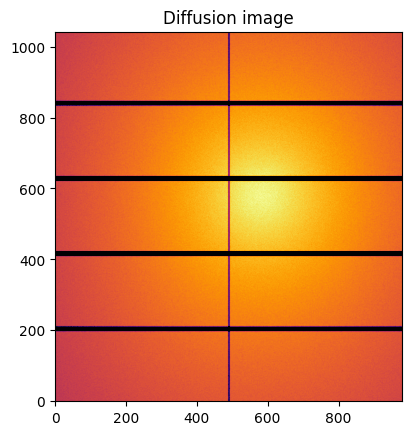
[11]:
res_theo = ai.integrate1d(img_theo, method=method, **kwargs)
jupyter.plot1d(res_theo)
[11]:
<Axes: title={'center': '1D integration'}, xlabel='Scattering vector $q$ ($nm^{-1}$)', ylabel='Intensity'>
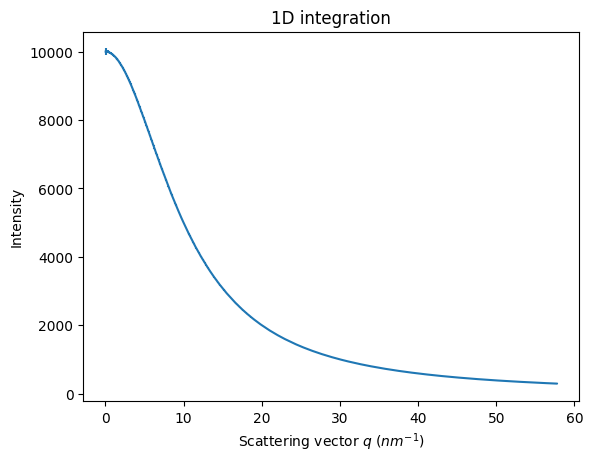
[12]:
%%time
if "dataset" not in dir():
dataset = numpy.random.poisson(img_theo, (nimg,) + img_theo.shape)
# else avoid wasting time
print(dataset.nbytes/(1<<20), "MBytes", dataset.shape)
7806.266784667969 MBytes (1000, 1043, 981)
CPU times: user 49.3 s, sys: 1.46 s, total: 50.7 s
Wall time: 50.7 s
[13]:
res_weighted = ai.integrate1d(dataset[0], method=weighted, **kwargs)
res_unweighted = ai.integrate1d(dataset[0], method=unweighted, **kwargs)
ax = jupyter.plot1d(res_theo, label="theo")
ax = jupyter.plot1d(res_weighted, label="weighted", ax=ax)
ax = jupyter.plot1d(res_unweighted, label="unweighted", ax=ax)
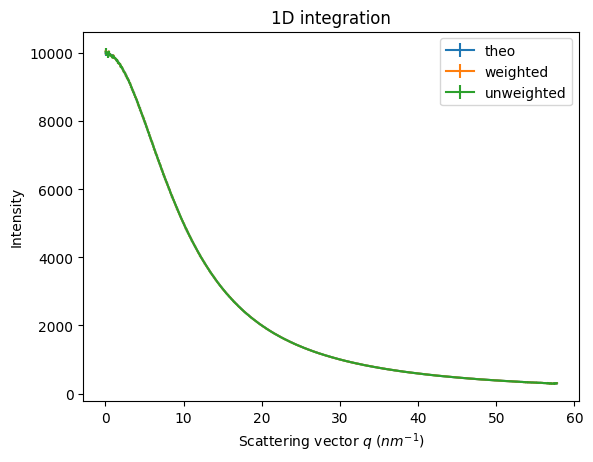
[14]:
fix,ax = subplots(2, figsize=(12,4))
ax[0].plot(res_theo.radial, res_theo.intensity, label="theo")
ax[1].plot(res_theo.radial, res_theo.sigma, label="theo")
ax[0].plot(res_weighted.radial, res_weighted.intensity, "3", label="weighted")
ax[1].plot(res_weighted.radial, res_weighted.sigma, "3",label="weighted")
ax[0].plot(res_unweighted.radial, res_unweighted.intensity, "4", label="unweighted")
ax[1].plot(res_unweighted.radial, res_unweighted.sigma, "4", label="unweighted")
ax[0].legend()
[14]:
<matplotlib.legend.Legend at 0x7f13cff2dad0>
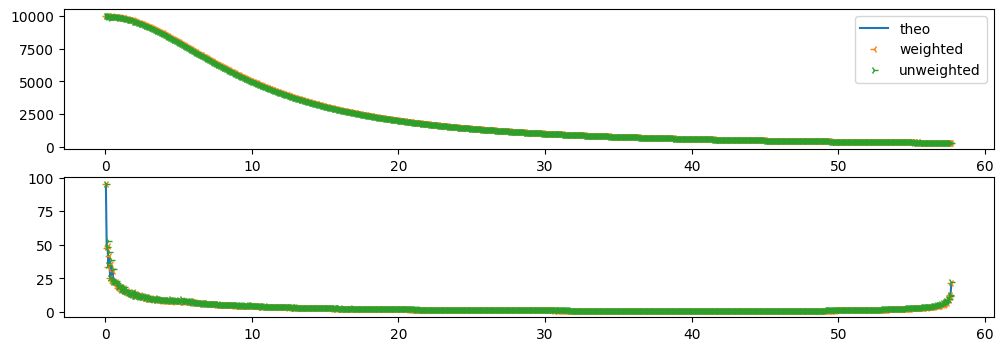
[15]:
print("Number of paires of images: ", nimg*(nimg-1)//2)
Number of paires of images: 499500
[16]:
def chi2_curves(res1, res2):
"""Calculate the Chi² value for a pair of integrated data"""
I = res1.intensity
J = res2.intensity
l = len(I)
assert len(J) == l
sigma_I = res1.sigma
sigma_J = res2.sigma
return ((I-J)**2/(sigma_I**2+sigma_J**2)).sum()/(l-1)
[17]:
def plot_distribution(ai, kwargs, nbins=100, method=method, ax=None):
ai.reset()
results = []
c2 = []
integrate = ai.integrate1d
for i in range(nimg):
data = dataset[i, :, :]
r = integrate(data, method=method, **kwargs)
results.append(r)
for j in results[:i]:
c2.append(chi2_curves(r, j))
c2 = numpy.array(c2)
if ax is None:
fig, ax = subplots()
h,b,_ = ax.hist(c2, nbins, label="Measured histogram")
y_sim = chi2_dist.pdf(b*(npt-1), npt)
y_sim *= h.sum()/y_sim.sum()
ax.plot(b, y_sim, label=r"$\chi^{2}$ distribution")
ax.set_title(f"Integrated curves with {integrate.__name__}")
ax.set_xlabel("$\chi^{2}$ values (histogrammed)")
ax.set_ylabel("Number of occurences")
ax.legend()
return ax
[18]:
fig,ax = subplots(1,2, figsize=(12,4))
a=plot_distribution(ai, kwargs, method=unweighted, ax=ax[0])
a.set_title("Unweighted")
a=plot_distribution(ai, kwargs, method=weighted, ax=ax[1])
a.set_title("Weighted")
[18]:
Text(0.5, 1.0, 'Weighted')
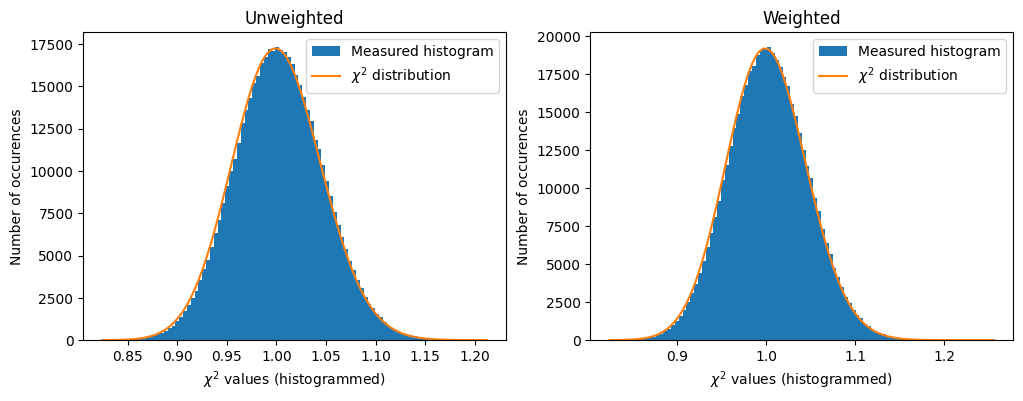
[19]:
print(rwp(ai.integrate1d(dataset[100], method=weighted, **kwargs),
ai.integrate1d(dataset[100], method=unweighted, **kwargs)))
0.07027319704675578
[20]:
print(f"Total run-time: {time.perf_counter()-t0:.3f}s")
Total run-time: 101.391s
Conclusion
The two algorithms provide similar results but not strictly the same. The difference is largely beyond the numerical noise since the Rwp between two results is in the range of a few percent. Their performances for the speed is also equivalent. Their results are different but on a statistical point of view, it is difficult to distinguish them.
To me (J. Kieffer, author of pyFAI), the question of the best algorithm remains open.
[ ]: